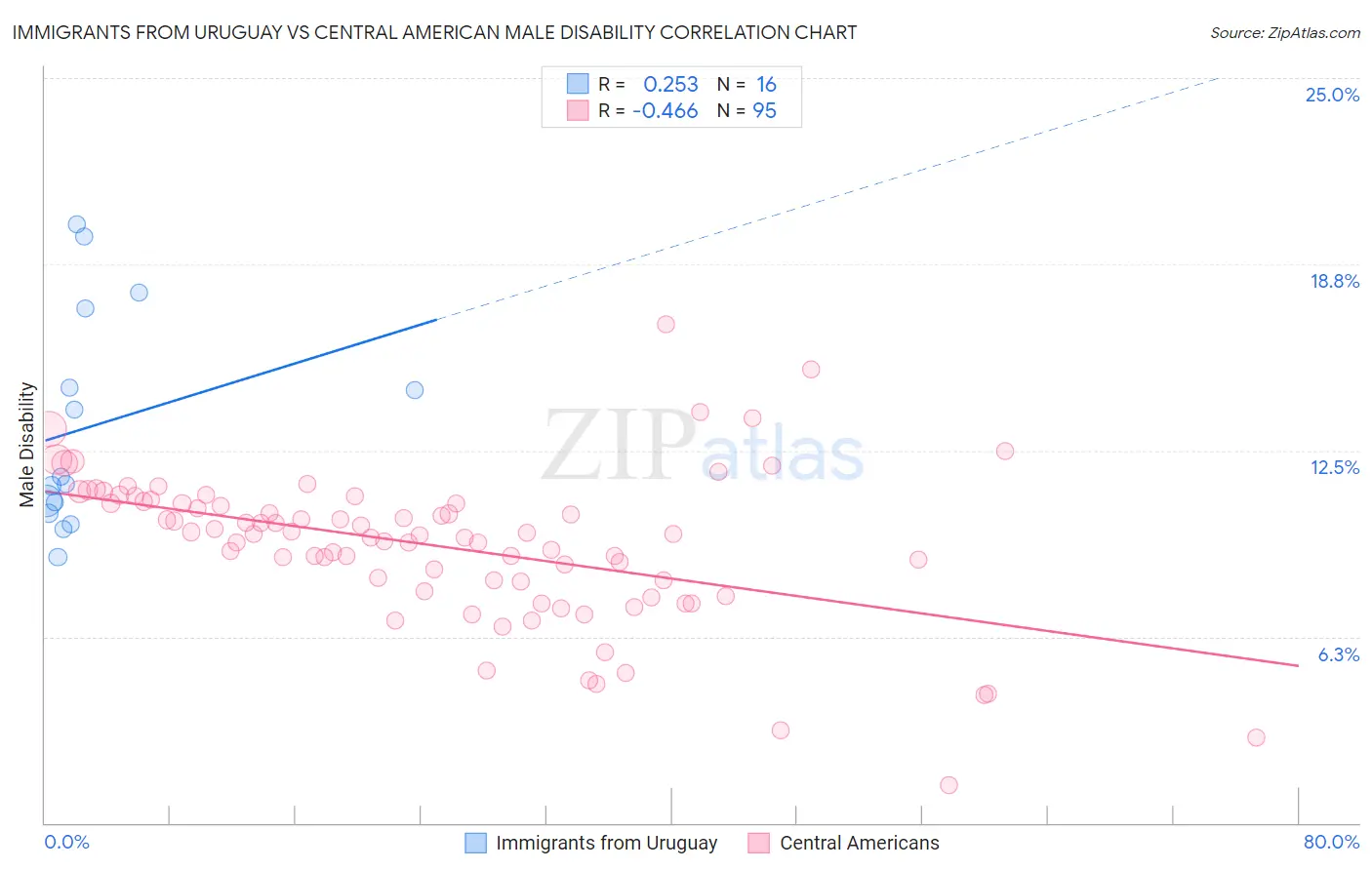Immigrants from Uruguay vs Central American Male Disability
COMPARE
Immigrants from Uruguay
Central American
Male Disability
Male Disability Comparison
Immigrants from Uruguay
Central Americans
10.8%
MALE DISABILITY
93.8/ 100
METRIC RATING
111th/ 347
METRIC RANK
10.8%
MALE DISABILITY
92.7/ 100
METRIC RATING
114th/ 347
METRIC RANK
Immigrants from Uruguay vs Central American Male Disability Correlation Chart
The statistical analysis conducted on geographies consisting of 133,255,356 people shows a weak positive correlation between the proportion of Immigrants from Uruguay and percentage of males with a disability in the United States with a correlation coefficient (R) of 0.253 and weighted average of 10.8%. Similarly, the statistical analysis conducted on geographies consisting of 504,432,725 people shows a moderate negative correlation between the proportion of Central Americans and percentage of males with a disability in the United States with a correlation coefficient (R) of -0.466 and weighted average of 10.8%, a difference of 0.25%.

Male Disability Correlation Summary
| Measurement | Immigrants from Uruguay | Central American |
| Minimum | 8.9% | 1.3% |
| Maximum | 20.1% | 16.7% |
| Range | 11.1% | 15.5% |
| Mean | 13.3% | 9.3% |
| Median | 11.5% | 9.7% |
| Interquartile 25% (IQ1) | 10.6% | 8.1% |
| Interquartile 75% (IQ3) | 15.9% | 10.8% |
| Interquartile Range (IQR) | 5.3% | 2.7% |
| Standard Deviation (Sample) | 3.6% | 2.5% |
| Standard Deviation (Population) | 3.5% | 2.5% |
Demographics Similar to Immigrants from Uruguay and Central Americans by Male Disability
In terms of male disability, the demographic groups most similar to Immigrants from Uruguay are Immigrants (10.8%, a difference of 0.040%), Immigrants from Uganda (10.8%, a difference of 0.060%), Ghanaian (10.8%, a difference of 0.10%), Immigrants from Belgium (10.8%, a difference of 0.11%), and Immigrants from Eastern Africa (10.8%, a difference of 0.13%). Similarly, the demographic groups most similar to Central Americans are Immigrants from Zimbabwe (10.8%, a difference of 0.070%), Immigrants from Barbados (10.8%, a difference of 0.10%), Ghanaian (10.8%, a difference of 0.15%), Immigrants from South Africa (10.8%, a difference of 0.17%), and Immigrants (10.8%, a difference of 0.29%).
| Demographics | Rating | Rank | Male Disability |
| Immigrants | Eastern Europe | 95.3 /100 | #102 | Exceptional 10.7% |
| Uruguayans | 95.3 /100 | #103 | Exceptional 10.7% |
| Immigrants | Nigeria | 95.1 /100 | #104 | Exceptional 10.8% |
| Immigrants | Brazil | 95.0 /100 | #105 | Exceptional 10.8% |
| Immigrants | Syria | 94.9 /100 | #106 | Exceptional 10.8% |
| Immigrants | Eastern Africa | 94.3 /100 | #107 | Exceptional 10.8% |
| Immigrants | Belgium | 94.2 /100 | #108 | Exceptional 10.8% |
| Immigrants | Uganda | 94.0 /100 | #109 | Exceptional 10.8% |
| Immigrants | Immigrants | 93.9 /100 | #110 | Exceptional 10.8% |
| Immigrants | Uruguay | 93.8 /100 | #111 | Exceptional 10.8% |
| Ghanaians | 93.4 /100 | #112 | Exceptional 10.8% |
| Immigrants | Zimbabwe | 93.0 /100 | #113 | Exceptional 10.8% |
| Central Americans | 92.7 /100 | #114 | Exceptional 10.8% |
| Immigrants | Barbados | 92.2 /100 | #115 | Exceptional 10.8% |
| Immigrants | South Africa | 91.8 /100 | #116 | Exceptional 10.8% |
| Eastern Europeans | 90.6 /100 | #117 | Exceptional 10.9% |
| Immigrants | Cuba | 90.2 /100 | #118 | Exceptional 10.9% |
| Armenians | 90.1 /100 | #119 | Exceptional 10.9% |
| Immigrants | Africa | 89.4 /100 | #120 | Excellent 10.9% |
| Immigrants | South Eastern Asia | 89.2 /100 | #121 | Excellent 10.9% |
| Immigrants | Ghana | 89.0 /100 | #122 | Excellent 10.9% |